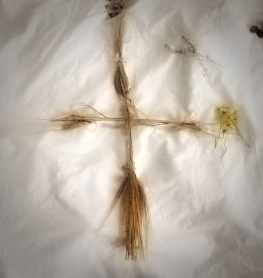28th July - Domhnach Crom Dubh
Written by Anne Newman - 27th July 2019
The last Sunday in July was known in Ireland as Domhnach Crom Dubh (‘dark, stooped one’).
Crom Dubh (originally Crom Cruiach) was the chief Celtic idol of Ireland. His main shrine was located on Magh Slécht (The Plain of Prostrations) in Co Cavan, surrounded by twelve other gods.
The pagan god Crom Dubh lived in the underworld throughout winter, emerging on 1st August to claim the ‘first fruits’, in the form of Eithne the corn maiden. He lifted her on his back (hence his stoop) and brought her down to the underworld.
 | Corn dolly representation of Crom Dubh - used in 2012 at a Lughnasdh gathering in Cork |
Dingle
On the Dingle Peninsula a great assembly was held on Domhnach Chrom Dubh in the village of Cloghane. The pilgrimage (turas) was made to the top of Mount Brandon at dawn. The ’rounds’ consisted of praying at St Brendan's ruined oratory and then encircling it and the pillar-stone and the ‘graves’ nine times while saying the Rosary,finishing up by taking a drink from the well.
Then the pilgrims went down to th village for the Patron. Traditionally the patron is commemorated the day on which the pagan chieftain Crom Dubh converted to Christianity. Crom lived at Ballyduff near Cloghane. His conversion legend tells of him slaughtering a bull in order to send the meat as a gift to St. Brendan.
A stone carving,
formerly kissed as a cure for toothache, in the wall of a local
church is said to represent Crom Dubh's head.
Croum Dhu was the god of
the harvest whom pagans worshipped.
Crom Dubh is associated with thunderstorms. It was said to be propitious if it lashed rain, with thunder and lightning on his day.
Co. Mayo
Crom Dubh is also
associated with Dún Briste (Broken Fort), Co Mayo. It is a
spectacular sea-stack which is approximately 50 metres in height. It
stands just off Downpatrick Head, in the townland of Knockaun, east
of the quiet village of Ballycastle. The stack is crowned by an old
ruined fort.
On Downpatrick headland itself, several archaeological monuments can be seen. These include Bronze-Age ring-barrows, early ecclesiastical sites and the remains of a promontory fort.
According to a local
legend Crom Dubh was an extortionate chief who lived at the present
Downpatrick Head; and he had two sons, Téideach and Clonnach, who
were even worse than himself.
The pagans, too of those days looked upon him as a kind of deity, though a cruel one. St Patrick being in the Province and hearing of his misdeeds, set out to visit him. Crom Dubh, on the Saint’s approach, set two fierce hounds at him but the Saint deprived them of their fierceness and likewise extinguished a fire into which Crom Dubh intended to throw him. The Saint’s endeavours to convert Crom Dubh being ineffectual, he struck with his crosier the ground before the chief’s house and caused that portion of the cliff to separate from the mainland, with the result that Crom Dubh and his son Téideach were imprisoned on it and perished. Clonnach, the other son, who was pillaging the country and was burnt in a conflagration of his own making. Ever since the people hold a pattern every year in honour of St Patrick at Kilcummin and at Downpatrick on the last Sunday of July, called in Irish ‘Crom Dubh’s Sunday’ (Domhnach Chrom Dubh).
Galway
Another story, this one from Galway, recounts how Crom Dubh was a wild speckled bull (tarbh breac) that killed travelers at Mam Ean. The mountain pass between two remote territories, was guarded by the pagan god Crom Dubh. The god was originally associated with fertility and good harvests, but the threat of Christianity made him watchful, and distrustful of strangers. When Crom Dubh saw St Patrick climbing towards him he changed his shape into a fierce bull and charged. There was a fearsome struggle as the saint wrestled with him. After some time, as the two forces pushed, heaved, and dragged each other over the mountainside, the saint eventually forced his enemy into Loch an Tairbh (the Bull’s Lake) where it drowned.
Armagh
In Armagh there is the story of a bull that prevented Patrick from building a church, so Patrick cursed him and he went mad, was eventually caught and killed, and buried under a standing stone at Corran.
Co. Limerick
The Ronadh Crom Dubh, or ‘the staff of Black Crom’ is a standing stone associated with a stone circle at Lough Gur in Co Limerick, where offerings of flowers and grain, not blood and death, are left at harvest time.
Croagh Patrick, Co. Mayo
Croagh Patrick, near Westport, is also known as The Reek. In pre-Christian times. Croagh Patrick was known as Cruachán Aigle. Some believe the older name is connected to a pagan harvest deity, the dark god Crom Crúaich, later known as Crom Dubh.
On Garland Sunday, the last Sunday in July, people climb to the top of the mountain in pilgrimage. Tradition has it that Patrick overcame Crom Dubh and took possession of the mountain. Here is where he banished the snakes and demons.
---oOo---
Anne is sharing a series of events throughout the year - you can find them listed by clicking to the link Other Notable Dates and Festivals.
There is more information on Crom Dubh and his Lughnasadh connections in Lughnasadh





